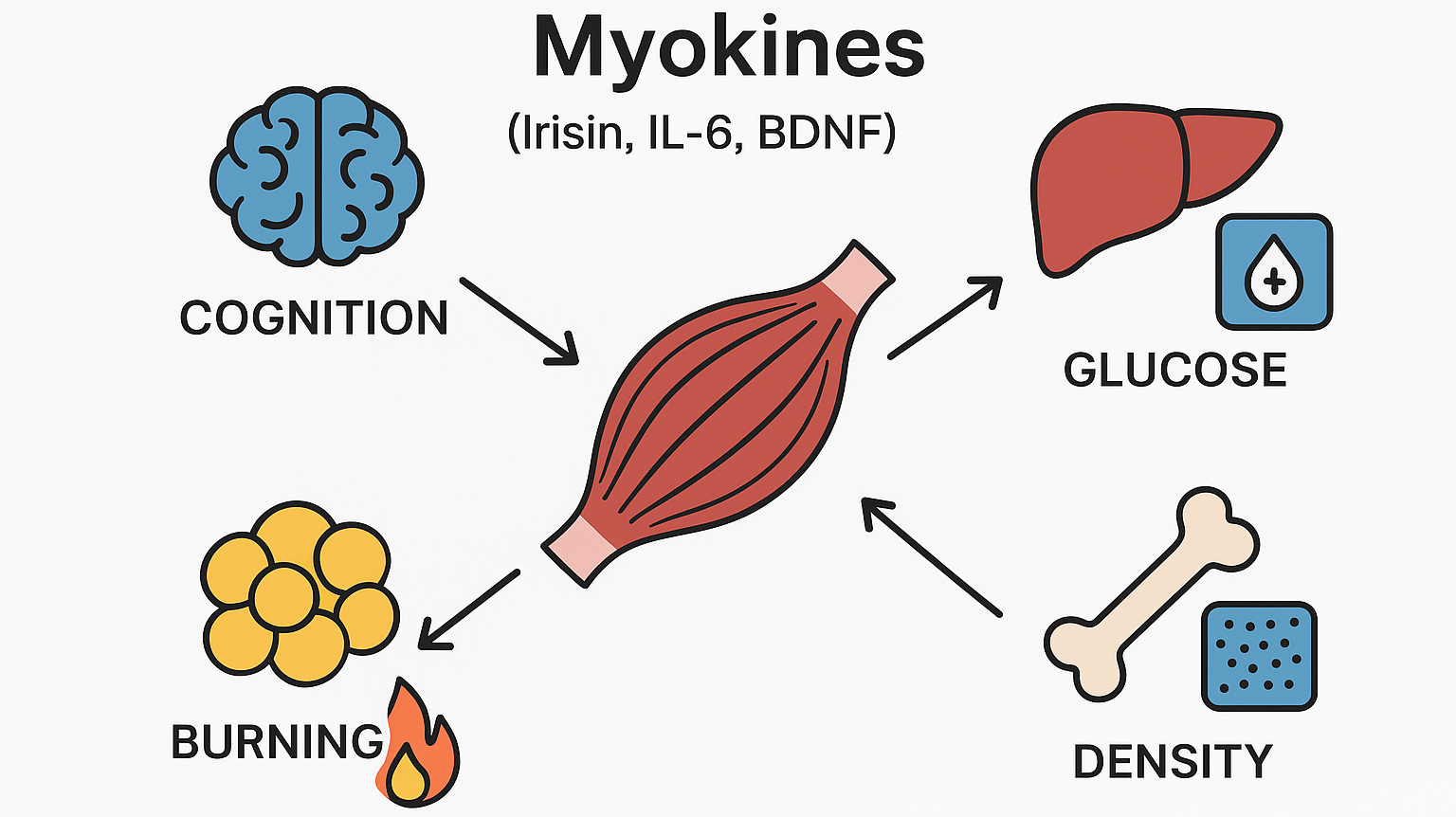How Exercise Unlocks Your Body's Hidden Messengers
When you think about your muscles, what comes to mind? Strength, movement, power, and perhaps aesthetics? For decades, we’ve viewed muscles as the body's motors—powerful but simple machinery dedicated to one job: contraction.
But what if that was just the beginning of the story? What if your muscles were also a sophisticated, secret pharmacy, manufacturing and releasing potent compounds that could heal your brain, re-engineer your metabolism, and reduce inflammation throughout your entire body?
Emerging science is radically redefining our understanding of muscle tissue. It’s not just a motor; it's a powerful endocrine organ. And the key to unlocking this pharmacy? The very act of exercise.
What Are Myokines? Your Body's Private Messengers
The game-changing compounds at the heart of this discovery are called myokines. The name comes from "myo" (muscle) and "kine" (messenger).
Myokines are a class of proteins and peptides that are produced and released by your muscle cells when they contract. Think of them as text messages sent by your muscles to the rest of your body. When you run, lift, or even walk briskly, your muscles are "talking" to your brain, your liver, your bones, and your fat tissue.
This system of communication, known as "crosstalk," is one of the most profound reasons exercise is so essential to human health. It means that a simple bicep curl isn't just a bicep curl; it's a signal to your entire body to heal, adapt, and get stronger.
The Science: How Exercise Sends the Signal
This isn't a passive process. Your muscles don't just leak myokines; they unleash them in direct response to being challenged.
When you contract your muscles, you create a metabolic stress. This challenge is the "on" switch. In response, your muscle fibers release hundreds of different myokines into your bloodstream. From there, they travel to distant organs, where they bind to specific receptors and give instructions.
The beauty of this system is that it's dose-dependent. The more consistently and intensely you train, the more robust this signaling becomes. This explains why the benefits of exercise are systemic, impacting everything from your mood to your metabolic health
The Body-Wide Benefits of Myokine Release
So, what are these "messages" actually saying? The instructions sent by myokines are overwhelmingly positive, commanding your body to become more resilient and efficient.
1. They "Brown" Your Fat
One of the most famous myokines is called Irisin. Research has shown that when released during exercise, irisin travels to your white adipose tissue (your body's primary storage fat) and helps convert it into "brown" or "beige" fat.
Why is this important? Unlike white fat, which just stores energy, brown fat is metabolically active. It's packed with mitochondria and its job is to burn calories to generate heat. By activating this browning process, your muscles are essentially telling your fat to stop storing and start burning, which dramatically improves insulin sensitivity and metabolic health.
2. They Remodel and Protect Your Brain
Your muscles are in direct communication with your brain. Exercise-induced myokines like Cathepsin B can cross the protective blood-brain barrier. Once inside, they promote neurogenesis—the creation of new brain cells, particularly in the hippocampus, the brain's memory center.
Other myokines, like Brain-Derived Neurotrophic Factor (BDNF), act like fertilizer for your brain cells, helping them grow, connect, and resist age-related decline. This is the direct, physical mechanism behind why exercise sharpens your focus, improves your memory, and acts as a powerful antidepressant.
3. They Fight Chronic Inflammation
Here's one of the most fascinating discoveries. For years, the protein Interleukin-6 (IL-6) was known as a pro-inflammatory signal. But scientists discovered a paradox: during exercise, muscles release huge amounts of it.
It turns out that context is everything. When IL-6 is released from muscle (not from fat or immune cells), it acts as a powerful anti-inflammatory agent. It helps mobilize fat for energy, improves insulin action, and signals your immune system to dial down chronic inflammation—the smoldering fire that is a root cause of most modern diseases, from heart disease to type 2 diabetes.
How to Maximize Your Myokine Release: Tools & Techniques
Understanding myokines is great, but how do we put this knowledge into action? The key is to generate the strongest possible "signal" from your muscles. This requires challenging them effectively and consistently.
While bodyweight exercises are a fantastic foundation, investing in a few key pieces of equipment can help you apply progressive overload (the process of gradually increasing the challenge) and ensure you're working your muscles in different ways.
For Resistance & Strength: This is arguably the most potent way to stimulate muscle fiber and trigger a robust myokine response.
Recommendation: Adjustable Dumbbells or Kettlebells. These are space-efficient and incredibly versatile. They allow you to perform hundreds of compound exercises (like squats, deadlifts, and presses) and, crucially, to increase the weight as you get stronger, which is essential for continuous adaptation.
For Intensity & Metabolic Stress: High-Intensity Interval Training (HIIT) and endurance cardio create a different kind of metabolic demand that also triggers a powerful myokine release.
Recommendation: A Quality Jump Rope or Stationary Bike. A jump rope is inexpensive, portable, and one of the most effective tools for HIIT. A stationary bike allows for controlled, high-intensity intervals without the high impact of running, making it a sustainable option for many.
For Consistency & Recovery: You can't send the signal if you're too sore or injured to train. Recovery is part of the training cycle.
Recommendation: A High-Density Foam Roller. Myokines are released during contraction, but the adaptation happens during recovery. Using a foam roller helps release muscle tightness, improve blood flow, and reduce soreness (DOMS), allowing you to get back to your next workout sooner and more safely.
Fueling the Messengers: Nutritional & Supplement Support
Exercise pulls the trigger, but your diet builds the bullet. Myokines are proteins, and your ability to train consistently relies on cellular energy and inflammation management.
The Building Blocks:
Recommendation: High-Quality Protein Powder (Whey, Casein, or Plant-Based). Myokines are proteins. After you train, your body needs amino acids to repair damaged muscle fibers and synthesize new proteins—including these vital messengers. A protein shake is a convenient and rapidly absorbed way to ensure your body has these raw materials exactly when it needs them.
The Energy Driver:
Recommendation: Coenzyme Q10 (CoQ10). This compound is essential for your mitochondria—the "power plants" inside every cell, especially your muscles. CoQ10 helps your mitochondria produce ATP (energy) more efficiently. Better energy production means you can train harder, creating a stronger contraction and a more significant myokine signal.
The Inflammation Manager:
Recommendation: Omega-3 Fatty Acids (Fish Oil or Algal Oil). As we saw with IL-6, inflammation is complex. We want to resolve chronic, low-grade inflammation while allowing the acute, healing response to exercise. Omega-3s (specifically EPA and DHA) are powerful anti-inflammatories that support this balance, promoting joint health, cardiovascular function, and even brain health.
The Muscle Function Modulator:
Recommendation: Vitamin D3. Often called a "pro-hormone," Vitamin D is critical for bone health, immune function, and, importantly, muscle contraction. Many people are deficient, and ensuring adequate levels can support your muscles' fundamental ability to function and respond to exercise.
The Takeaway: Your Workout is a Conversation
This science forces us to rethink what exercise is. It's not just about calories in, calories out. It's not just about building bigger muscles.
Your workout is a chemical conversation with your entire body.
Every repetition, every step, and every drop of sweat is a signal to your internal pharmacy to release a potent cocktail of healing. You are instructing your fat to burn, your brain to grow, and your body to heal itself.
Your muscles are not just for movement. They are the primary engine of your health, your body's most powerful command center. By choosing to move, and by supporting your body with the right tools and nutrition, you are taking direct control of your biology, one myokine at a time.
Works Cited
Pedersen, B. K., & Febbraio, M. A. (2012). Muscles, exercise and organs: role of myokines in clinical importance. Nature Reviews Endocrinology, 8(8), 457–465. https://doi.org/10.1038/nrendo.2012.72
Schoenfeld, B. J., & Pedersen, B. K. (2013). The role of myokines in fat-muscle crosstalk. Journal of Physiology and Pharmacology, 64(5), 511-516.
Jedrychowski, M. P., Wrann, C. D., Paulo, J. A., et al. (2015). Detection and quantitation of circulating human Irisin by tandem mass spectrometry. Cell Metabolism, 22(4), 734–740. https://doi.org/10.1016/j.cmet.2015.08.001
Gere-Paszti, E., & Fésüs, L. (2018). Exercise-Mediated Crosstalk of Skeletal Muscle and Brain. Frontiers in Physiology, 9, 747. https://doi.org/10.3389/fphys.2018.00747
Egan, B., & Zierath, J. R. (2013). Exercise metabolism and the molecular regulation of skeletal muscle adaptation. Cell Metabolism, 17(2), 162–184. https://doi.org/10.1016/j.cmet.2012.12.012




